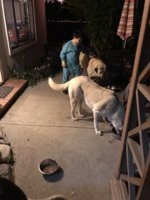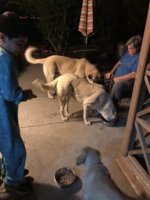Ttennis
Chillin' with the herd
I'm new here and I refrain from posting in FB groups because I usually get chastised, so please be kind I'm still learning.
I have a small 1 acre farm with chickens, 1 steer, 2 sheep, and 2 LGD. The steer is a pet, and I got him when he was 3 days old. Our first LGD we got as a puppy, 8 weeks old. He is a Pyr/Anatolian/Akbash. His parents were working dogs, and the pups were born in the pasture along with many other animals- sheep, goats, chickens. We brought him home and kept him with the baby calf. They were best friends and cuddled together every night. When they were 6 months old we introduced a female puppy who was also born on a farm with working parents and exposed daily with livestock. She is a Pyr/Maremma/Anatolian and has a very sweet temperament. As youngsters, they would all dabble in each others food until we ultimately made separate feeding/resting areas. The last couple months the male has become very food agressive and started attacking the steer who was trying to get into his food. The barn was completely separated so that there was zero interaction while eating. Now the steer can't even walk by the opening of the dog side or look in that direction without the male going after him. Today he was going after the female who wanted a bite of food. Then I was comforting the steer and he started barking going after the steer in the pasture, and continued to go after him even when I left and watched from a distant.
I get conflicting information. The two people I got the livestock dogs from say, keep them together as puppies with the livestock so they bond. Other 'LGD groups' say absolutely keep them separate (The dogs/steer) until they are at least 2 years old, even though they have been together since they were all babies.
These are our first LGD and livestock, so it's all new to us. I'm planning on putting the steer with the sheep this weekend and keeping the dogs separate in the pen next to it. I just want to do the right thing, and I don't know which way is right.
I'm open to learning and suggestions
I have a small 1 acre farm with chickens, 1 steer, 2 sheep, and 2 LGD. The steer is a pet, and I got him when he was 3 days old. Our first LGD we got as a puppy, 8 weeks old. He is a Pyr/Anatolian/Akbash. His parents were working dogs, and the pups were born in the pasture along with many other animals- sheep, goats, chickens. We brought him home and kept him with the baby calf. They were best friends and cuddled together every night. When they were 6 months old we introduced a female puppy who was also born on a farm with working parents and exposed daily with livestock. She is a Pyr/Maremma/Anatolian and has a very sweet temperament. As youngsters, they would all dabble in each others food until we ultimately made separate feeding/resting areas. The last couple months the male has become very food agressive and started attacking the steer who was trying to get into his food. The barn was completely separated so that there was zero interaction while eating. Now the steer can't even walk by the opening of the dog side or look in that direction without the male going after him. Today he was going after the female who wanted a bite of food. Then I was comforting the steer and he started barking going after the steer in the pasture, and continued to go after him even when I left and watched from a distant.
I get conflicting information. The two people I got the livestock dogs from say, keep them together as puppies with the livestock so they bond. Other 'LGD groups' say absolutely keep them separate (The dogs/steer) until they are at least 2 years old, even though they have been together since they were all babies.
These are our first LGD and livestock, so it's all new to us. I'm planning on putting the steer with the sheep this weekend and keeping the dogs separate in the pen next to it. I just want to do the right thing, and I don't know which way is right.
I'm open to learning and suggestions


